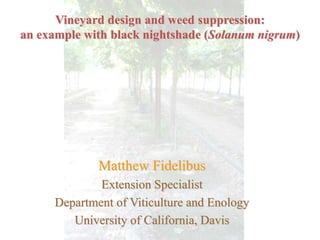Weed suppressive cropping systems
- 1. Vineyard design and weed suppression: an example with black nightshade (Solanum nigrum) Matthew Fidelibus Extension Specialist Department of Viticulture and Enology University of California, Davis
- 2. Challenges to Weed Control in San Joaquin Valley (SJV) Vineyards ? Economic: Profit margins are slim and the ĄźcostĄŻ of weeds in mature vineyards is uncertain ? Environmental: šC Air and water pollution are major problems in the SJV šC Regulation of dust emissions may curtail mechanical controls. šC Herbicide use restricted in some SJV vineyards to protect groundwater ? Biological: Many weed species are resistant to common herbicides
- 3. Weed control a low priority in some raisin vineyards Photo courtesy of Kurt Hembree, UCCE
- 4. Dust emissions from vehicles, equipment and wind are regulated
- 5. Herbicide resistant horseweed discovered in SJV, 2005 Photo courtesy of Anil Shrestha, CSUF
- 6. New production concepts present opportunities to reassess vineyard design which could affect the ecology of vineyard weeds
- 7. OBJECTIVES: Determine whether row orientation of open gable DOV trellis system affects the light environment of weeds growing in the rows. If so, could such differences potentially help manage weeds?
- 9. MATERIALS AND METHODS 3-4 leaf black nightshade (Solanum nigrum) plants were transplanted into 9-l pots
- 10. MATERIALS AND METHODS Pots placed beneath the canopy of raisin grapes in rows oriented East-West (E-W) or North-South (N-S) in April
- 11. MATERIALS AND METHODS Quantity and quality of light available to weeds measured weekly 3-times a day (9 AM, 12 PM, 3 PM). Photosynthesis and water use of weeds were also measured.
- 12. MATERIALS AND METHODS Weeds were harvested 2 months after planting and separated into: roots, stems, leaves and berries Leaf area was measured and each plant part was dried and weighed
- 13. SEASONAL SHADOW PATTERNS IN THE VINEYARD East-West North-South 9 AM 12 PM 4 PM PAR 12 PM 0 400 800 1200 1600 PAR 4 PM Date 0 400 800 1200 1600 PAR 9 AM PAR(?molm -2s-1) 0 400 800 1200 1600 NS EW 5/9 5/27 6/24
- 14. 0 10 20 30 40 50 6.30 7.30 8.30 9.30 10.30 11.30 12.30 14.30 15.30 16.30 17.30 18.30 19.30 Time of day (hrs) Lightlevel(%offullsun) N-S E-W Typical light under the grape canopy zones of the N-S and E-W rows DAILY LIGHT MICROENVIRONMENTS
- 15. Row orientation 9 AM 12 PM 4 PM EW 0.26 0.24 0.24 NS 0.87 0.24 0.82 P-value 0.005 0.81 0.009 Red: Far Red ratio
- 16. 2004 0 200 400 600 800 1000 1200 1400 EW NS 2003 PAR ( mol m-2 sec-1 ) 0 200 400 600 800 1000 1200 1400 Photosynthesis(molCO2 m-2 s-1 ) 0 5 10 15 20 25 Nightshades Need About 30% Full Sun for Optimal Photosynthesis
- 17. Clear effects on morphology, but not in shoot mass N-S E-WFull sun
- 18. Leaf characteristics of nightshade E-W N-S Larger, thinner leaves in E-W compared to N-S; This might make them more susceptible to herbicides
- 19. Nightshade roots Full sun N-S E-W Root mass and R:S ratio declined with shade; full sun > NS > EW
- 20. Leaf (33%) Stem (34%) Fruit (18%) Root (14%) Leaf (27%) Stem (31%) Fruit (24%) Root (17%) E-W N-S Row Orientation Affected How the Weeds Used their Resources Weeds in EW were light deficient; they invested more in leaves and stems, and less in fruits and roots than weeds in NS
- 21. Seed return of nightshade Row orientation Berries (No.) Seeds/berry (No.) Seeds/plant (No.) EW 155 47 7151 NS 184 51 8976 P-value .07 .004 .03
- 22. CONCLUSIONS ? Row direction affected light environment of weeds in this trellis and spacing system ? The growth and productivity of weeds was dependant on their to the light environments; weeds in EW rows produced 20% fewer seeds than weeds in NS rows ? An integrated approach to vineyard design can provide one of the Ą°many little hammersĄ± needed to help manage weeds
- 23. Acknowledgements Dr. Anil Shrestha Kimberley Cathline Jorge Osorio Aguilar
Editor's Notes
- #2: Thank Anil Shrestha
- #3: Some herbicide have high VOCs
- #14: Dark soil from water may look like shadow, but soil below N-S rows was sunlit in the morning and afternoon whereas it was constantly shaded in EW
- #16: Lower R:FR could promote shade avoidance strategies. Weed canopy zone (WCZ) in EW rows have lower R:FR in morning and afternoon.























